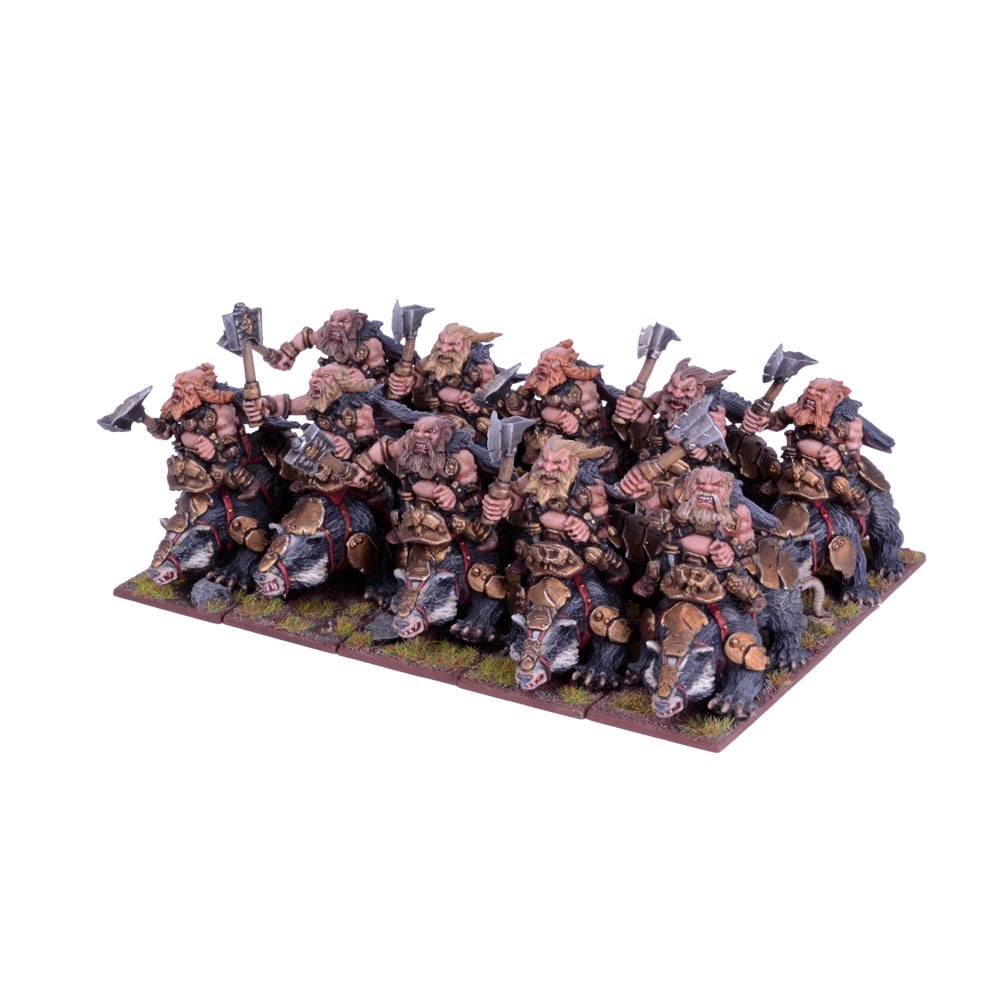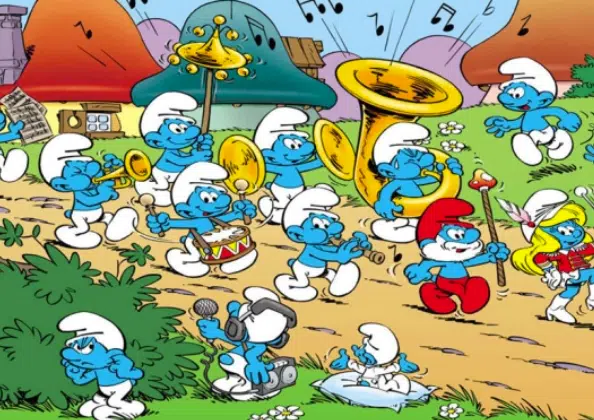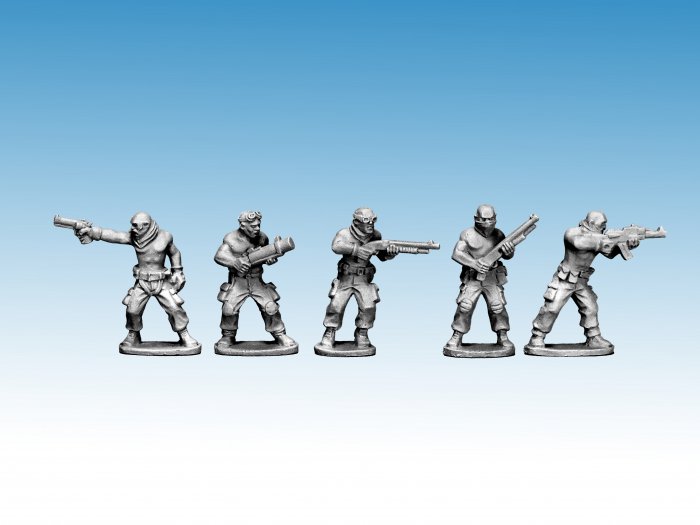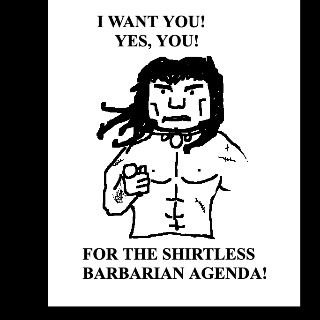I went with "other" - I'd rather see WA's artists and sculptors let their imaginations go someplace unique that nobody else has done before.
At the bottom of my list of things I'd want to see is to ape GW exactly, in any case!
That said, I like Grumpy's use of converted GW goblins - the mushrooms, Phrygian caps, bushy beards and eybrows, and bright colours are a great combination there that really evokes Traditional Fantasy goblins for me, and it doesn't at all come across as "garden gnome" or "smurf" - those guys look like they're jolly and playful if you leave them alone and stay well out of their way, but they get darned mean if you mess with them:

That's brilliant work.
The gnomes, traditionally, are earth elementals - primordial spirits who owned the earth long before humans invaded their territory. They're cousins of the dwarves, goblins, brownies, tommyknockers, kobolds, poltergeists, domovoi, will-o-wisps, witches, banshees and all sorts of other malignant "playful" spirits - you either made your treaties with them, and left tribute, bribes, or gifts for them, and stayed out of their way - treated fairly, they ran your gardens and house by night, while you occupied them by day. Like any of the "fair folk" and "little people", they might be portrayed as cute or beautiful to appease them, but in spite of the flattery, wise folk know that it's best to shower gnomes with gifts, build a home or garden for them, and leave them in peace.
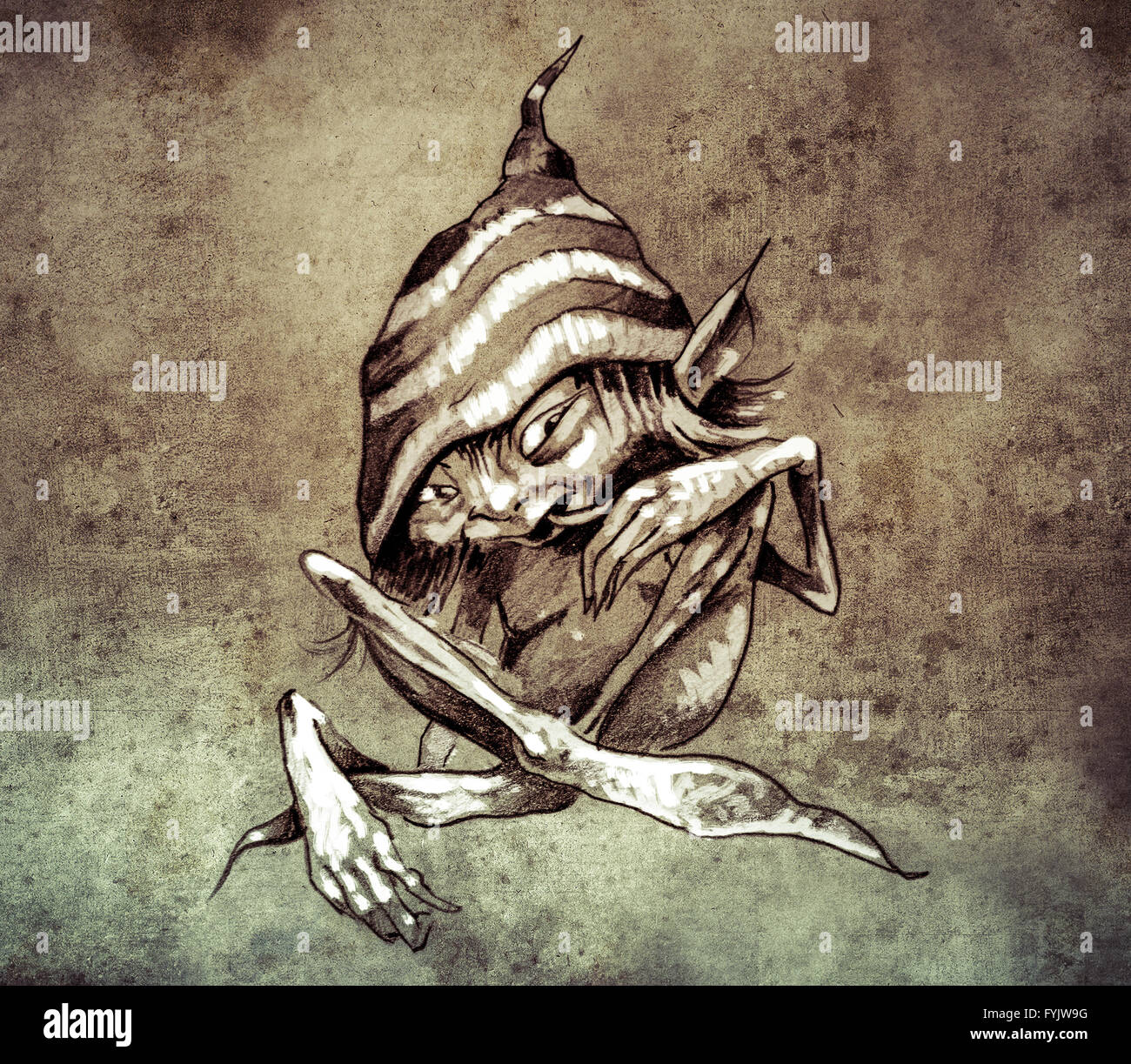
But if you treated the gnomes poorly, they were not at all cute - they were the stuff of nightmares - a haunted house was as likely to be haunted by these elementals as they were to be human ghosts, and in the Christian era being haunted by the likes of gnomes would be indistinguishable from a demonic attack - disembodied voices, things being moved or thrown about, farm animals being killed in mysterious ways, food being ruined, and so on. These were, for all intents and purposes, "demons" worshiped by pagans who'd made their treaties with them and made their sacrifices of food and treasure and space for the gnomes.
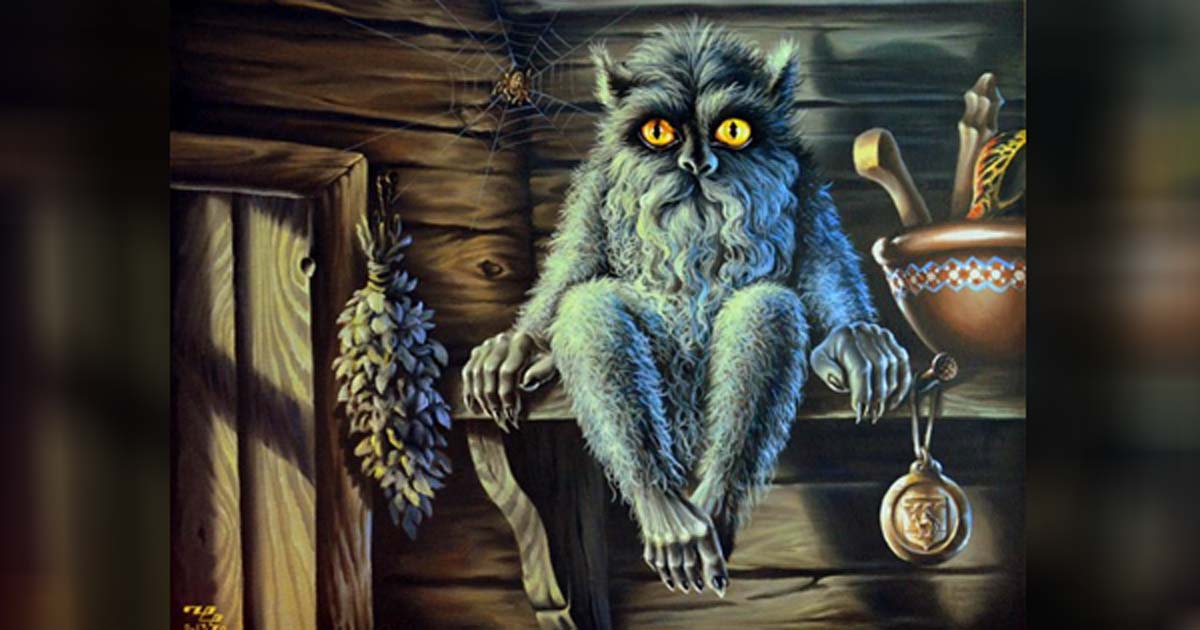
One might suggest that there is as much of - if not more of - the Lovecraftian "Old Ones" in the old stories of gnomes, as there is of the playful Victorian-era garden gnome characters: potentially malignant humanoid forces of nature living right at the fringe of the explored reality of the ancient world, capable of holding families on the frontiers of the known world hostage in a reign of supernatural terror, unlesss suitabily appeased with an appropriate pact by those would become virtual cultists to the creatures. But, if you can make peace with them, your household gnomes can be powerful allies, protecting the home from even more malignant beings, and doing special favors (see the old tale of the shoemaker and the "elves"!)

Domovoi: one of the more 'tame" and "civilized" gnomes!
So, I think there are two sides the gnomish coin: that playful, jolly side, and a far darker, more dangerously prankish side - and like any wild spirit, those two sides aren't really so far apart from each other - the gnomes could be as changeable as the weather - as the elements - and should be treated with care.
In D&D:
Traditionally, D&D's gnomes are like playful dwarves, who they get along with splendidly, and appeared as one of the player-character races, favoring illusionist spell-casting classes, and using hooked hammres as weapons. The 4th edition of D&D infamously dropped gnomes as PC characters, and statted them up instead as monsters, with comedy ensuing! I believe that changed again with 5th edition, with gnomes becoming exiles of a sort of elemental nature dimension, who are in constant danger of fading away the longer they spend in our world, with adventuring being one of the few things that helps to keep them from losing their gnomishness.
I'm a bit out of touch with how anyone else uses gnomes in D&D these days - I'd be as happy using them (like dwarves, elves, humans, halflings, goblins, orcs, or any other humanoids) as both monsters and as friendlies for PCs to work against or for, depending on the situation and how the PCs navigate it. I'm a bit eccentric that way, though - I don't think I've ever heard of other D&D groups using gnomes as anything other than PC characters, and those emphasizing only the jolly, playful side of gnomes.
The difficulty...
The difficulty with gnomes, much like dwarves, elves, goblins, hobgoblins, orcs, kobolds, ghouls, ogres, trolls, werewolves, vampires, witches, and many other fairy creatures is that they mostly draw from the same well of folklore describing much the same primordial elemental spirits - it's more or less the same legend, given a different name and a slightly different description.
The basic idea was developed to some extent (in its troubled, Victorian way) in Margaret Murray in e.g. The Witch-Cult in Western Europe and James Frazer's The Golden Bough (both a big influence over pulp horror/fantasy/sci-fi writers like Robert E. Howard and H.P. Lovecraft): the myths and folklore of Europe supposedly descend cultural memories of an Old Religion - the "witch-cult" - held by a primordial race that was driven out of mainstream Europe into the fringes of the wilderness. That elder race - the witches, gnomes, fairies, goblins, satyrs, nymphs, and such of legend - was attributed with the powers of casting spells, shape-shifting, drinking the blood of victims, and so on, while worshiping their secret nocturnal cult of horned devil-gods and moon goddesses in sacred groves and fields in the dark, in between waging a secret war on the civilized people who encroached on their wild lands. This elder race would be the mound-builders of prehistoric European cairns and barrows: passage-tombd leading deep into a mysterious underworld into which the fairy-folk retreated against the advances of civilization, emerging only by night to work their mischief and spite upon the invaders by the light of the full moon: these are the prototypical "undead" of the fairy world, the wights, ghouls, revenants, vampires, and such, the shape-shifting were-creatures of the night, the devil-bought witches, the flesh-eating ogres, the subterranean dwarves guarding dungeons full of buried treasures....
The tortured Victorian pseudo-science aside (these books have been largely discredited, of course, living on mainly in pulp fiction and in the New Age movement), these works were highly influential in their day, and do manage to point out the close relationship between many of the creatures of folklore and modern fantasy gaming: whether they be orcs, ogres, ghouls, werewolves, drow elves, vampires, or witches, these creatures are very frequently spell-casting, sub-terranean cannibals with a hatred of human life, dwelling on the outskirts of civilization. Whether poltergeists, tommyknockers, witches, goblins, kobolds, or gnomes, they tend to be mischievous creatures of the night who haunt the living folk who have invaded their homes. Dwarves, gnomes, dark elves, goblins, and orcs live in their underground tunnels, guarding hordes of treasure. Wild men, orcs, elves, ogres, giants, and trolls haunt to forests at the fringes of civilization. Werewolves, vampires, witches, trolls, and "little people" of all sorts are skilled shapeshifters, changing size or changing form into bats, wolves, cats, owls, serpents, and worms....
In short, the problem in Fantasy Kitchen Sink gaming is that all of these creatures kind of step on each others' toes a little, sharing a little bit in common with each other, and threatening to crowd each others' spaces!
There's two ways you can go with this:
- You can just embrace the similarities wherever they work for you, blurring the lines between the different "breeds" of fairy creatures as you see fit. (What's the difference between a gnome and a goblin? Nothing really, except whether you're on their good side or bad side....)
- This can actually be fun in an RPG, and probably in an open-ended enough war game - try it sometime! (What's the difference between a werewolf and a goblin warg? Not much, depending on how literally you take the idea of "wolf-riders"!)
- It's all in how you dress them up to fit the rest of your world-building concept - pick little bits of the folklore you like from different takes on the them, and add some interesting depth back into your version of orcs or whatever. (What's the difference between a witch and an orc spell-caster? Dark elves and ghouls or orcs, or morlocks or derros? Not a whole lot, in spirit! For example, perhaps ghouls are orcs that, possessed by unclean spirits, have made their homes among the tombs. When your orc hordes go marching, be sure to bring a regiment of their ghouls, dressed in gravely rags and carrying morbid totems made from their favorite tomb-loot....)
- You can try to forge distinct identities for each of your breeds of fairy-folk, compartmentalizing them into as unique a role as you can. Some of the options:
- Cosmetic appearance. (What's the difference between gnomes and goblins? One is Euro-flesh-coloured and smiling, the other is green and angry looking, and that is important!)
- Size. (What's the difference between a goblin and a hobgoblin or orc? Goblins are smaller!)
- Battlefield role. (What's the difference between a goblin and an orc? Orcs are heavy infantry, goblins are skirmishers and cavalry, while gnomes are illusionist spell-casters!)
- Environment. (What's the difference between a kobold and a goblin? Goblins are albino, troglodytic, wizened creatures found mostly in caves or outside the caves by night, while kobolds are reptilian creatures who haunt the deserts like djinn, emerging from their burrows to warm themselves in the blazing sunlight by day.... Or, kobolds live underground in mines and caves, while goblins live in forests and woodlands, making their homes in hollow trees....)
- Theme. (Gnomes are close to nature, using elemental magic and clever illusions to hide their forest homes among the mushrooms; they've taken flowers, mushrooms, and woodland animals for their theme! In contrast, Goblins are a more industrial or technological race, as depicted in Tolkien's The Hobbit: inventing many clever devices, but no beautiful things... they favor the drab colours of factory coveralls, and take up gears and hammers for their symbols....)
- Cultural analogy - AKA "Creatures from the Planet of the Hats". (Persian gnomes are very different from English goblins, and I call dibs on the orcs in cowboy hats!)
- Take a third option: Any outside-the-box third option you can think of, no matter how off-the-wall, can work, given the "fantasy kitchen sink" nature of most modern gaming. This includes inventing something new and original out of whole-cloth, like those dragon-like kobolds, or 40K's fungus-like orcs that infest worlds like an invasive species, or those unsettling, troglodytic, morlock-like dwarves from Skyrim....
- The less like anything Games Workshop, Tolkien, D&D, World of Warcraft, and the like have done before, the better! (What would happen if your gnomes looked and acted more like sci-fi "little green men" and/or "grey aliens", than they do jolly, playful garden gnomes? These are intensely curious and enigmatic invaders from another world - fairyland - with the power, among other things, to replace people with soulless pod-people doppelgangers.... Give these otherworldly gnomes short, spindly bodies, large, bulbous heads, big, dark eyes, bland expressions, and optional long beards and caps to go with some retro-sci-fi costumes, and crystal-powered wands and other such devices.... As such, let them double for sci-fi aliens for Death Fields!)

No matter how silly a Phrygian cap might look, it won't make a face like that any less creepy....
I think I slightly prefer borrowing a little bit from all over the spectrum of fairytale folklore, blurring the lines a little in the process, followed closely by doing something really off-the-wall and different, but none of these methods of world-building is really wrong,
Anyway, TL;DR: I like Grumpy's goblin conversion, and think those - like the best gnomes IMHO - are those that mix a little of the stereotypical jolliness and whimsy, with something darker and more dangerous.
But, the more I think of it, the more I think that "little-grey-men" style gnomish invaders from an alien fairyland sound like they could be pretty darned cool!








































